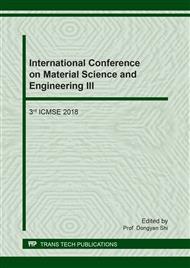[1]
T. Wang et al., Mechanical Properties with High Temperature and the Microstructure of Carbon/Phenolic Ablative Composites, J. Wuhan University of Technology-Mater. Sci. Ed. 27(5) (2012) 967–972.
DOI: 10.1007/s11595-012-0583-3
Google Scholar
[2]
B. Evans et al., Comparison of Nozzle Throat Erosion Behavior in a Solid-Propellant Rocket Motor and a Simulator, 45th AIAA/ASME/SAE/ASEE Joint Propulsion Conference & Exhibit Denver (2009).
DOI: 10.2514/6.2009-5421
Google Scholar
[3]
S. Costa e Silva et al, Effect of the Fiber Orientation Relatively to the Plasma Flow Direction in the Ablation Process of a Carbon-Phenolic Composite, J. Aerosp. Technol. Manag. 7(1) (2015) 43-52.
DOI: 10.5028/jatm.v7i1.437
Google Scholar
[4]
R. Balaji et al., Effect of Microsilica in Woven Ceramics Fibre/Phenolic Resin Composites, Int. J. Res. Eng. Tech. 3(5) (2014) 609–613.
Google Scholar
[5]
Z. Bu et al., Novel silicon-modified phenolic novolac resins: Non-isothermal curing kinetics, and mechanical and thermal properties of their biofiber-reinforced composites, Thermochimica Acta 575 (2014) 244–253.
DOI: 10.1016/j.tca.2013.11.003
Google Scholar
[6]
M. Natali et al., Phenolic matrix nanocomposites based on commercial grade resols: Synthesis and characterization, Comp. Sci. Tech. 70 (2010) 571-577.
DOI: 10.1016/j.compscitech.2009.12.005
Google Scholar
[7]
Y. Jiang et al., Effect of polyphenenylsisesquioxane on the ablative and flame-retardation properties of ethylene propylene diene monomer (EPDM) composite, Polym. Degr. Stabil. 96 (2011) 949-954.
DOI: 10.1016/j.polymdegradstab.2011.01.034
Google Scholar
[8]
J. Lu, Synthesis of Phenolic Resin Amines and Solid-State NMR of Phenolic Resin in NASA Rocket Motors, Mississippi State University (1998).
Google Scholar
[9]
H. P. Silva et al., Shear Properties of Carbon Fiber/Phenolic Resin Composites Heat Treated at High Temperatures, J. Aerosp. Technol. Manag. 8(3) (2016) 363-372.
DOI: 10.5028/jatm.v8i3.643
Google Scholar
[10]
J. S. Tate et al., Carbon/Phenolic Nanocomposites as Advanced Thermal Protection Material in Aerospace Applications, J. Comp. 2013 (2013) 1-9.
Google Scholar
[11]
H. T. Chu et al., Experimental study of ablative materials by oxyacetylene flame flow system, International Conference on Industrial and Intelligent Information (ICIII 2012) IPCSIT vol.31 (2012).
Google Scholar
[12]
A. R. Bahramian et al., Ablation and Thermal Degradation Behaviour of a Composite Based on Resol Type Phenolic Resin: Process Modeling and Experimental, Polym. 47(10) (2006) 3661-3673.
DOI: 10.1016/j.polymer.2006.03.049
Google Scholar
[13]
Z. Chen et al., Comparison of Morphology and Microstructure of Ablation Centre of C/SiC Composites by Oxy-Acetylene Torch at 2900°C and 3550°C, Corr. Sci. 50(12) (2008) 3378-3381.
DOI: 10.1016/j.corsci.2008.07.019
Google Scholar
[14]
N. Winya et al., Study of factors affecting the ablation rate of phenolic resin/fiber glass, Int. J. Chem. Eng. Appl. 4 (2013) 234–237.
DOI: 10.7763/ijcea.2013.v4.302
Google Scholar
[15]
M. Biron, Thermosets and Composites, Second Edition: Material Selection, Applications, Manufacturing and Cost Analysis, William Andrew (2013).
Google Scholar
[16]
M. R. Orpin, The use of fire-safe phenolic composite materials in marine applications, Cruise & Ferry '93, London (1993).
Google Scholar


